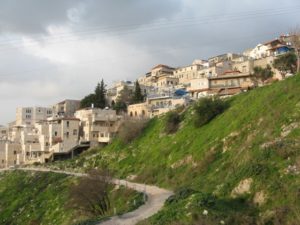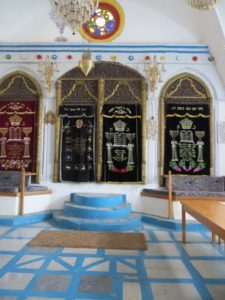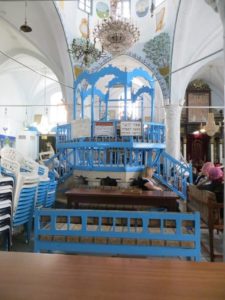 Record numbers of tourists are expected in Israel in 2014. While the tourists include visitors from around the world and represent dozens of cultures and religions, Jewish visitors generally travel to Israel to experience their own history and heritage.
Record numbers of tourists are expected in Israel in 2014. While the tourists include visitors from around the world and represent dozens of cultures and religions, Jewish visitors generally travel to Israel to experience their own history and heritage.
For many years one of Israel’s most fascinating sites, Safed, was all but ignored by most tourists. The city is located up on a mountaintop in Israel’s northeastern panhandle and most tour guides didn’t think that their tourists would enjoy the sleepy, dusty town. In recent years however the number of visitors to Safed has grown as people look for a more spiritual component to their Safed trip. Today Safed is a mandatory stop on many tours for groups and individuals who come to explore the mystical and historic spots that are scattered throughout the Old City.
History
Safed is known as one of Judaism’s Four Holy Cities. The city rose to prominence as center of Kabbalistic learning in the 16th century when rabbis and Kabbalists made their way to Safed after fleeing the Spanish Inquisition. Safed became a center of Jewish mysticism and by the mid-1500s more Jews lived in Safed than in Jerusalem.
Safed experienced two significant earthquakes, one in the 18th century and the second, a devastating one, in the 19th century. These earthquakes caused landslides that reduced the city to rubble and although Jewish survivors returned to rebuild, the city never regained its 16th century prominence. Throughout the city visitors can see the tops of arches which indicate the presence of windows and doors of buried homes. Some of these rooms have been excavated and tourists can see them at the the Safed Tourist Information Center. There is also a 10-minute movie about the history of Safed at the Center.
Synagogues
Jews lived in Safed for thousands of years. Little is known of the early residents of Safed until the Crusader era when the Crusaders recorded the presence of Jews along with Moslem and Christian Arabs. When the first Jewish exiles began to arrive in the city after the Spanish Expulsion of 1492 they found a small backwater town but the town’s location, along the Acre-Damascus trade route, ensured economic security.
The earthquakes destroyed almost all of Safed’s original synagogues but a 19th century donor funded their restoration on their original sites, in their traditional styles. Those are the synagogues that are seen today throughout the Old Jewish Quarter.
Ari Ashkanazi
The Ari Ashkanazi synagogue was originally called the “Girigos” synagogue. It was established by refugees who had fled Spain to the Greek island of Girigos after undergoing forcible conversion to Christianity. This was a common  during this era but the established Jewish community refused to accept converted Jews back into the Jewish world. The Girigos Jews built their synagogue on the then-outskirts of Safed. When Rabbi Isaac Luria — the ARI, a great Kabbalistic rabbi — came to Safed he chose to conduct his new pre-Shabbat service of psalms and songs in the field next to the Girigos synagogue. This service came to be known as the “Kabbalat Shabbat” and is today recited before Shabbat in synagogues and temples throughout the world.
during this era but the established Jewish community refused to accept converted Jews back into the Jewish world. The Girigos Jews built their synagogue on the then-outskirts of Safed. When Rabbi Isaac Luria — the ARI, a great Kabbalistic rabbi — came to Safed he chose to conduct his new pre-Shabbat service of psalms and songs in the field next to the Girigos synagogue. This service came to be known as the “Kabbalat Shabbat” and is today recited before Shabbat in synagogues and temples throughout the world.
Following the ARI’s death the the Girigos Jews were welcomed back into the mainstream community and the synagogue was renamed “Ari Ashkanazi.”
Ari Sepharadi
Prior to the ARI’s arrival in Safed in 1570 the Ari Sepharadi was called the “Eliyahu HaNavi” — Elijah the Prophet — synagogue. According to legend the Ari sat inside a small cave in the synagogue where he studied Kabbalah with Elijah the Prophet. After the earthquake of 1837 local residence believed that the synagogue was haunted and for many years no one entered the synagogue. The Baba Sali, a Moroccan Kabbalist, visited Safed in 1921 and performed a kabbalistic incantation to banish the spirits.
Abuhav
 According to local legend the Abuhav synagogue was built in Spain by Rabbi Abuhav who then magically transported the building to Spain when the Inquisition threatened to destroy the synagogue. Other versions of the story claim that Rabbi Abuhav planned the synagogue in Spain and then built it in Safed.
According to local legend the Abuhav synagogue was built in Spain by Rabbi Abuhav who then magically transported the building to Spain when the Inquisition threatened to destroy the synagogue. Other versions of the story claim that Rabbi Abuhav planned the synagogue in Spain and then built it in Safed.
The Abuhav synagogue is one of Safed’s most famous synagogues. It features a blue domed interior with kabblistic-inspired etchings. There are three Arks of the Torah which house the regular Torah scrolls which are used daily as well two old Torah scrolls which were written by 15th century Kabbalists Rabbi Ohana nd Rabbi Abuhav. The third ark once housed the Koran, a requirement that the 15th – 20th Ottoman Turks rulers imposed on all of their empire’s houses of worshop. Today the ark is a geniza and is used to store holy texts.
Yosef Caro Synagogue
Rabbi Yosef Caro a comprehensive summary of Jewish customs and laws, in Safed in the 16th century. According to the legend an angel — the Magid — guided him in this masterpiece as they sat together in the small cave of the synagogue.
The original Caro synagogue building is located below today’s Yosef Caro synagogue. It can be entered during morning hours.
The present Yosef Caro synagogue is built in the Sepharadi tradition. Thel “bima” sits in the center of the synagogue and seats surround the bima. An ancient geniza is located behind glass walls along the synagogue’s perimeter.
Old Safed Cemetery
Graves
Jewish tradition relates that prayers which are recited near a gravesite of a holy man or woman are transmitted straight to heaven. Many visitors in Safed descend into the Safed cemetery where they can pray at the gravesites of the ARI, Rabbi Yosef Caro, Rabbi Alkabetz, Rabbi Alsheich, Rabbi Ya’akov Beirav, Rabbi Haim Vital, Rabbi Moshe Cordevero and other great rabbis and kabbalists.
The cemetery also contains gravesites which are believed to date back to the Talmudic period including graves of Hannah and her Seven Sons, Hoseah the Prophet and Rabbi Pinchas Ben Yair.
Ari Mikve
Along the mountainside on the southern side of the cemetery, the ARI mikve draws men (women are not allowed) year-round. Legend states that the mikve was once used as a spring where bodies were washed before buriel. When the ARI died, he spoke as his dead body was being washed in this spring. This gave rise to the belief that miracles occur to those who immerse in the Ari mikve’s waters. A word to the wise, especially for visitors who come during winter months — the ARI Mikve is not heated.
Art
Safed began to expand in the mid 20th century following the War of Independence. Among the immigrants who settled in the city were some of Israel’s finest artists. These artists established a bohemian artists community in the area where tourists could wander to see their work. Today the majority of the galleries have migrated to Josef Caro Street in the Old Jewish Quarter where tourists can see various types of Judaica and Israel-inspired art. A number of Kabbalistic artwork is displayed by American born Safed artists including Daniel Flatauer (pottery), Sheva Chaya Servetter (glass blowing and watercolors), Dovid Friedman and Avraham Lowenthal.
Laurie Rappeport is originally from Detroit. She made aliyah in 1983 and has lived in Safed since 1985. She spent 13 years working with the Livnot U’Lehibanot Israel Experience Program and continues to be active in bringing visitors to Safed via her website.

